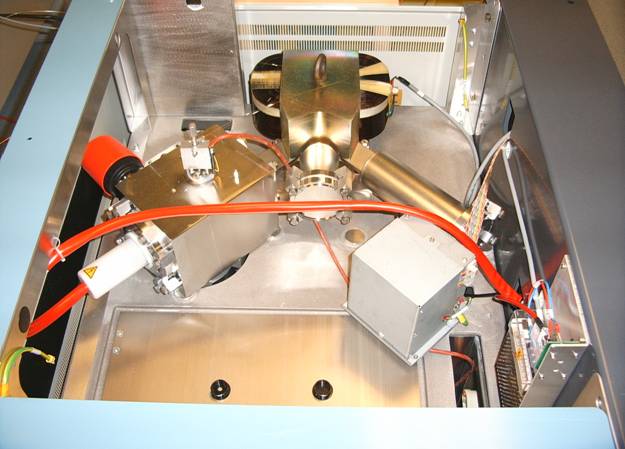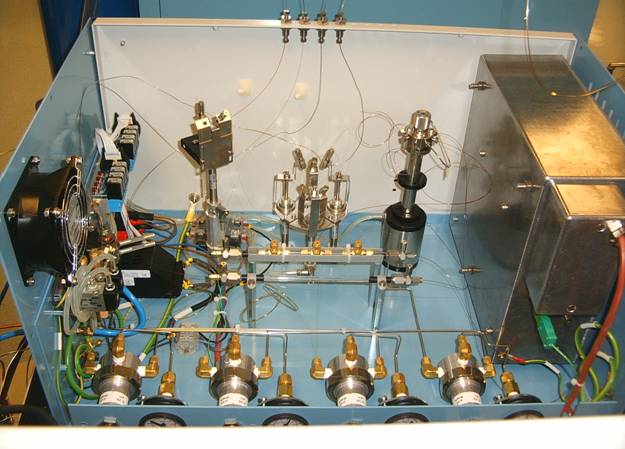Instrumentation in the KFLEB includes a Neptune multicollector ICP-MS and an iCap-Q ICP-MS, along with a Thermo MAT 253 and a Thermo Delta Plus Advantage MS with a wide variety of peripheral inlet devices for sample preparation. These give us the capability to analyze elemental concentrations and isotopic ratios over much of the periodic table in a wide variety of sample matrices.The lab has a dual purpose to provide up-to-date analytical capabilities and to train users in the use of the instrumentation and correct data processing. Two of the ICP mass spectrometers in the laboratory are operated by Dr. Ariel Anbar's group, while the third (a second Neptune) is operated by Dr. Meenakshi Wadhwa's group.
Groups wishing to use these facilities should contact the lab manager. Although fees will be charged, the facility is not primarily a service lab in the traditional sense. Ideally, trained users will run their own samples and process the results under the supervision of the lab manager. In this way they may get a better idea of how the instrumentation works and of the analytical details involved in obtaining those results. With appropriate training and user interest, it should be possible to remove the "black box" effect that is common with analytical instrumentation.
See the pages for IRMS and ICP-MS for details on available analyses.
Q-ICP-MS (iCap-Q)
The Quadrupole ICP-MS (iCap-Q) is used for rapid, precise and accurate trace (<1000 ppm) element determinations in liquid and solid samples, isotopic determinations, and speciation studies. The iCap-Q features a stable plasma source capable of ionizing most elements of the periodic table, an interface system to transfer ions from the high temperature (6000-10,000°K- atmospheric pressure (760 torr) environment of the Ar plasma into the mass spectrometer analyzer region at room temperature and low pressure (10-5 torr), technology to remove interferences, and an autosampler is capable of handling 240 15- ml samples at a time. The iCap-Q is used to determine the concentration of metals, REE, and some major elements in a wide variety of sample types and over a large dynamic range
Thermo Neptune
The Neptune MC-ICP-MS is designed for high-precision isotope ratio analyses of much of the periodic table, and has high mass resolution to resolve polyatomic interferences from the analytes of interest. The Neptune has a doubly focusing plasma source, which allows simultaneous multi-collection to obtain high precision isotope ratio measurements, and movable Faraday cups. The Neptune is used for high-precision isotope ratio analyses of much of the periodic table with high mass resolution to resolve polyatomic interferences from the analytes of interest. Validated analytical techniques include radiogenic Sr and Pb isotope ratios, and mass dependent Ca, Cr, Fe, Ni, Cu, Zn, Rb, Sr, Mo, Cd, Re, Hg, and U. Other can be developed upon request.
Thermo MAT 253
The MAT 253 is a magnetic sector mass spectrometer with a 10KV high sensitivity ion source and Faraday cups. It is used for high resolution isotope ratio mass spectrometry. Can be used for TC/EA, gas bench, or GCC sample introduction peripherals.
Thermo Delta Plus Advantage
The Delta Plus Advantage is a magnetic sector mass spectrometer with a 3kV ion source. It is used for isotope ratio mass spectrometry. The Delta Plus can be attached to either a TOC analyzer or an elemental analyzer for C isotopes in waters or C and N in solids. Ours has no H collectors and is limited to C, N, O, and S analysis.
Costech Elemental Analyzer
The Costech EA is a flash combustion peripheral coupled to an isotope ratio mass spectrometer. It is used for the determination of elemental and isotopic compositions of C and N, most frequently in soils, plant matter, and organic matter.
The Costech EA was originally developed for the determination of elemental composition of a sample. This device generates CO2 from carbon, N2 from nitrogen, H2O from hydrogen, and SO2 from sulfur (special furnace packing is needed for this element). The sample gases are chromatographically separated using a PoraPlot column and then individually passed over a TCD detector and quantified. The effluent is then vented from the room. For isotope analysis, some modifications are made. H2O is a terrible compound to get into an isotope ratio mass spectrometer. Hence, a magnesium perchlorate water trap is used to remove water from the gas stream. The effluent from the instrument is sent to a Conflo Interface so that a small amount of this gas stream is sent to the mass spectrometer for isotopic analysis. With the EA we can thus measure 13C, 15N, and 34S isotope ratios. It must be remembered that this instrument works by pulsing some O2 into a hot (1020°C furnace) for combustion. Hence we cannot measure oxygen isotopes with this device.
Thermochemical Elemental Analyzer (TC/EA)
The TC/EA is a high temperature (1350°C to 1450°C) device that thermally decomposes samples in a carbon reducing environment to break down waters, organic, and inorganic samples (nitrates, phosphates, and sulphates). It is used for determination of total C, H, N, and O content in a wide range of organic and inorganic substances. In our current lab configuration the TC/EA is coupled to the MAT 253, which allows us to measure H and O ratios of waters and solids.
The TC/EA is basically a high temperature (1350°C to 1450°C) furnace packed with glassy carbon chips to form a strongly reducing environment. When organics are introduced into the furnace all carbon is deposited as graphite, organic oxygen reacts with glassy carbon to form CO, hydrogen is converted to H2, and sulfur is (presumably) reduced to a sulfide (S2-). The instrument can perform these conversions on organics and also on some inorganics. For example, oxygen isotope ratios may be measured in dry, solid sulfates, phosphates, and nitrates. Additionally, some work has shown that inorganic nitrogen isotope ratios can also be measured from nitrate and ammonium salts.
OI Analytical TOC Analyzer
The OI Analytical TOC Analyzer uses heated persulfate wet oxidation to determine the total amount of dissolved inorganic carbon (DIC) and dissolved organic carbon (DOC) in an aqueous sample. It works by initial addition of 10% phosphoric acid to a sample solution at close to 100°C. All dissolved inorganic carbon (in the form of bicarbonate or carbonate) is driven off as CO2. The CO2 driven off is removed by a continuous flow of helium and streamed past an infrared detector. Sodium persulfate (a peroxide: ie. a very strong oxidant) is then added to the solution and all organic carbon is oxidized to CO2. This second pulse of gas is also carried past the IR detector for quantification. This instrument operates at near ambient pressures (ie. gauge pressures of 1 to 2psi) and hence is difficult to couple to a Conflo interface for IRMS measurements. However, Gilles St. Jean (from the Hatch Lab at U. of Ottawa) developed an interface that cleans up the gas stream from the TOC analyzer and allows isotope analysis to be performed on the effluent. The interface is shown here:
GasBench and Heating Block
The GasBench is a headspace sampling peripheral for IRMS. It is used for carbonate C and O isotope analysis, O and H analysis of waters, and headspace gas analysis. Below is a front view of the heating block and PAL autosampler (by CTC Analytics). The GasBench interface is the box behind the PAL. In the back is Brandon McLean, a former graduate student in Everett Shock's lab. In our current setup we have the GasBench plumbed into the MAT 253 for use for either carbonate C and O analysis or headspace gas analysis.
View inside of the GasBench interface. In center back is the reference gas open split. To the left of that is the sample gas open split. On the right side is the 8-port valve with sample loop. The box on the far right is a small GC oven. In front are three valves for reference gas control and one valve for overall helium pressure. There are additional inlets for the flush gas on the left side. We have two cryotraps installed on the GasBench as well.
Gas Chromatography-Combustion (GC-C) and Gas Chromatography-Thermal Conversion (GC-TC) Mass Spectrometer
The GC-C/TC Mass Spectrometer is for compound-specific analysis of light stable isotope ratios of C, N, O, and H. It combines the features of gas-liquid chromatography and mass spectrometry.








